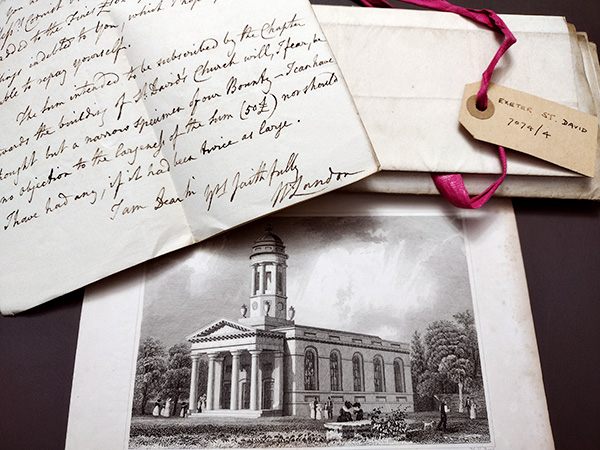
By Ellie Jones, Cathedral Archivist
Saint David, whose feast day falls on 1 March, was a 6th century Welsh bishop best known as a patron saint of Wales, but also of vegetarians and poets. There has been a church in Exeter – about one mile from the Cathedral – dedicated to St David for over 800 years.
The site of St David’s Church may be ancient, but there have been several very different churches bearing that dedication. A 15th century church was replaced in 1816/17 by one in the Greek revival Doric style, fashionable in Britain in the late 18th and early 19th centuries. Designed by James Green, it had a distinctive octagonal tower surrounded by eight Doric pillars, and was topped off with a rounded dome. The foundation stone was laid on 4 June 1816, and it was consecrated by the Bishop of Exeter a year later, on 24 September 1817. The Dean & Chapter were among those who contributed funds to the project. The Dean, Whittington Landon, wrote to Ralph Barnes, the Chapter Clerk, on 11th Jun 1816 declaring:
“The sum intended to be subscribed by the Chapter towards the building of St David’s Church will, I fear, be thought but a narrow specimen of our Bounty – I can have no objection to the largeness of the sum (50£) nor should I have had any, if it had been twice as large”.
New transepts and galleries added in 1839 greatly increased the church’s capacity, but it was not to be long-lived. It was demolished in 1897, and the present church, designed by William Douglas Caröe in the late Gothic revival style, was consecrated by the Bishop of Exeter on 9th January 1900.
James Green (1781-1849) was a civil engineer, originally from Birmingham, who spent much of his career in the south west of England. He worked principally on canal, bridge and drainage works, but also roads, houses and municipal buildings. In 1808 he was appointed as the first County Surveyor of Bridges in Devon, and then County Surveyor. Not all of the projects were a success though, and eventually financial problems ensued. During the 1830s he took on more work outside Devon and was eventually dismissed from his role as County Surveyor in 1841. Elmfield House – the home Green had built on St David’s Hill in 1810 – still exists, but is better known to locals today as The Imperial (a Wetherspoon’s).